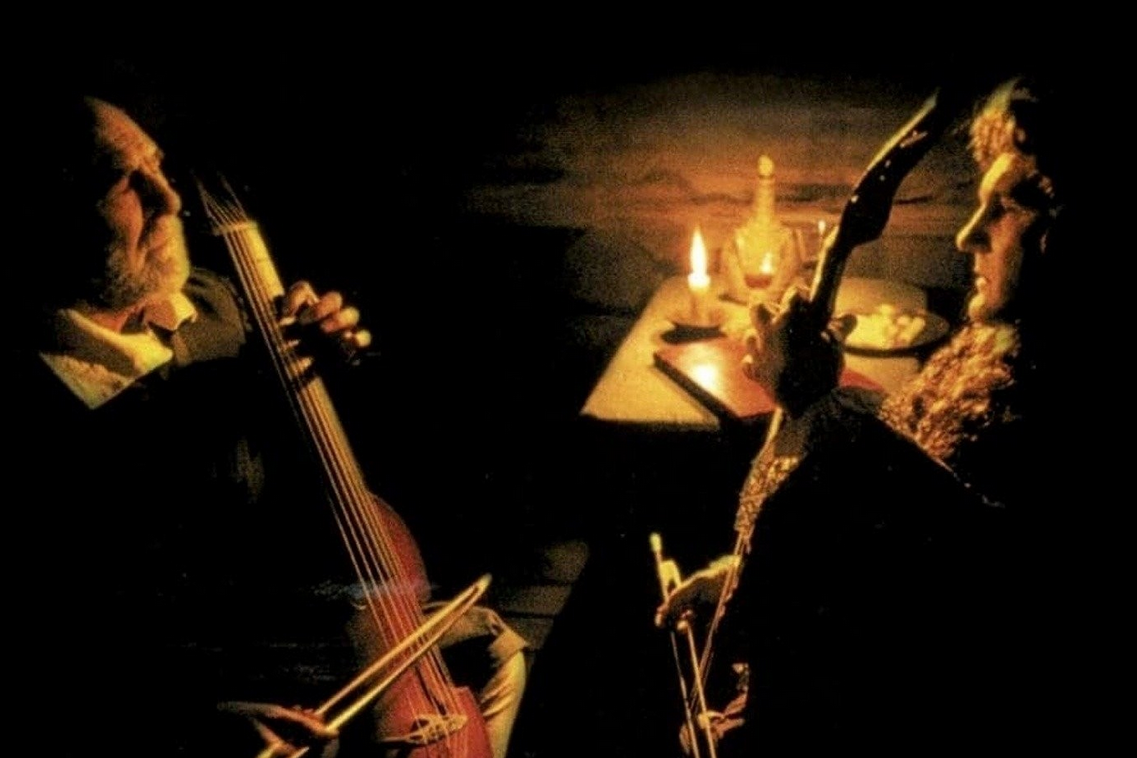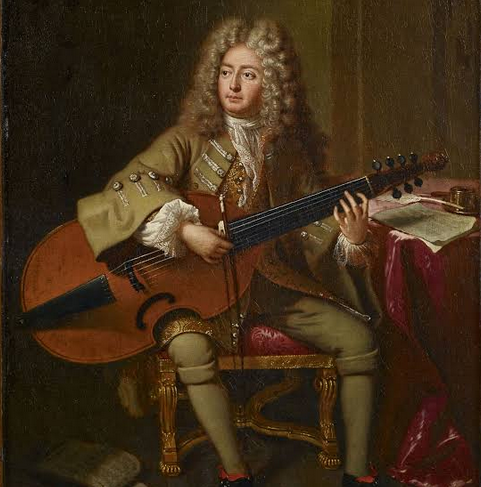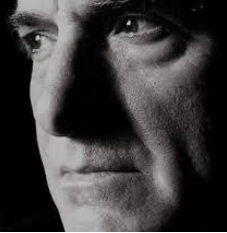
Music isn’t completely human. – Sainte-Colombe
The fifteenth-century viola da gamba (Italian, “viol for the leg”) or gamba, is played straddled like a cello. But the resemblance ends there. It is smaller and more delicate. It has five to seven strings, rather than the four of a cello, is tuned in fourths, rather than perfect fifths, with a third in the middle, similar to a guitar or lute, and has frets of tied gut that are movable or removable. The guitar-like tuning allows expressive arpeggiated chords and the flexible fret system allows pitch adjustment unavailable to the modern violin family (violas da braccio, or viols for the arm). The gamba’s haunting plaintive timbre is unique amongst old classical instruments, creating a sound akin to a sorrowful voice. It is ideal for moods of melancholy, although J.S. Bach composed many duets for gamba and harpsichord which are quite gay.
My first close experience with the viola da gamba was when I was writing a three-part setting of the short poems of the sixth-century poet Sappho, titled Evocation of Sappho. It’s said that Sappho recited or sang her poems to the accompaniment of the Greek eight-string barbiton lyre but as I couldn’t find one of those outside of a museum, I thought perhaps the gamba might substitute. Fortunately, a brilliant gamba player-teacher, Miriam Morris, lived two streets over from me in Carlton North. I gave her a short score notation of the melody and she came up with a wonderful accompaniment for my song. I asked her to improvise an extended instrumental piece for the ending. She did it in one take and I included this second movement, Fragment 64, on my 2008 album, freelovedays.
This review appears in the latest Quadrant.
Click here to subscribe
All the Mornings of the World (1991; original title: Tous les matins du monde) is a French film, directed by Alain Corneau, adapted from the novel of the same name by Pascal Quignard, and stars Gerard Depardieu as the seventeenth-century French composer Marin Marais and Jean-Pierre Marielle as master viol player Sainte-Colombe. In a piece of inspired casting, Depardieu’s son Guillaume plays the younger Marais. The exquisite music throughout the movie was composed by Marais, Sainte-Colombe and the Italian-French Baroque composer and guitarist Jean-Baptiste Lully. The soundtrack features the contemporary master viol player Jordi Savall.
In the opening of the film, Marin Marais, composer to the Court of Versailles under King Louis XIV, is an older man reflecting on his life. He remembers his youth and his mentor, Sainte-Colombe. The story now flashes back to his past.
Since the death of his wife, Monsieur de Sainte-Colombe has become highly regarded as a popular performer, playing in a viol consort with his two daughters, Madeleine and her little sister Toinette. Louis XIV, a lover of dance and music, has heard of the extraordinary musicianship of Sainte-Colombe and invites him to perform at Versailles, but Sainte-Colombe refuses. In retaliation, the King ensures that no one henceforth will employ the virtuoso. Sainte-Colombe confines himself to a small studio he has built behind his manor where he drinks and composes melancholy gamba pieces. The spirit of his dead wife is often in the room, sitting across from him while he plays.
A few years later, a very young Marin Marais arrives at the Sainte-Colombe manor to request instruction. After a few reluctant lessons, the teacher in frustration explains, “You play music but you are no musician,” and dismisses him. But, the elder daughter, Madeleine, has fallen in love with Marais and teaches him some of her father’s innovative gamba techniques. Madeleine becomes pregnant with Marais’s child, but he leaves her. The child is stillborn. Marais subsequently marries a lady from the King’s court. Madeleine grows ill and requests Marais to return one last time and play a piece he composed for her. He agrees, but after he leaves, she hangs herself.
Years later, Marais, world-weary and, as Handel once said, well “acquainted with grief”, visits the elderly Saint-Colombe one last time. This time the old master acknowledges that the former student has finally grasped the true essence of music and gives him his blessing.
The French director Alain Corneau originally intended to be a professional musician. He started his film career as an assistant to the celebrated Greek film-maker Costa-Gavras.
Gerard Depardieu has had one of the most prolific careers in movie history, having appeared in 250 films, mostly in lead roles. In his youth he was a street kid, practically illiterate until the age of thirteen. He liked fighting and studied boxing. He sold stolen goods, and was put on probation. He later worked as a bodyguard for Parisian prostitutes. He underwent therapy to correct his diction and improve his memory and taught himself to study classic literature. He starred in Bertolucci’s 1900 alongside Robert De Niro and played opposite Catherine Deneuve in Francois Truffaut’s The Last Metro. From then on, he was in great demand.
Guillaume Depardieu (the young Marais) was born in 1971 and is the eldest son of Gerard Depardieu. He had a troubled relationship with his famous father but reconciled with him in later years. After a motorcycle accident, he had his leg amputated. He became addicted to drugs, contracted viral pneumonia and died at the age of thirty-seven.

Jean de Sainte-Colombe (1640–1700, above) was a composer, credited with adding the seventh string to the viola da gamba. Hardly anything is known about his life. No doubt much of how he is portrayed in the movie is conjecture. He is shown as a wounded individual who shunned public performance, but it is recorded that he performed publicly in the Parisian salons. He often appeared in concert playing with his two daughters. Marais was his most notable student. Another of his proteges was the composer and theorist Jean Rousseau, who praised his innovations in left-hand technique. Sainte-Colombe composed over 170 pieces for the solo seven-stringed viol. He was absent from home, performing for a dying patron, when his wife died, paralleling the later life of J.S. Bach who had also been away on a business trip when first wife, Maria Barbara Bach, passed away. When Bach returned home, his wife had already been buried. Whereas Sainte-Colombe never married again and, according to accounts, mourned his late wife for the rest of his life, Bach remarried the following year to Anna Magdalena Wilcke, a soprano sixteen years his junior. Together they had thirteen children.
Marin Marais was born in 1656 in Paris and studied composition with the great Jean-Baptiste Lully and conducted Lully’s operas. He studied with Sainte-Colombe for only six months. Little is known of his personal life—he had nineteen children—and he is attributed, along with Sainte-Colombe, as one of the two leading composers for the gamba. He apparently also had a keen sense of humour. One of his works, The Bladder-Stone Operation, has composer’s notes such as “the patient is bound with silken cords” and “he screameth”. Jordi Savall said, “Marais is perhaps the only composer for bowed instruments who annotates every nuance very precisely in the score,” which has aided immeasurably the understanding of how this kind of music was actually played in the time—not with strict mechanical precision, as had been thought, but with great emotion and freedom of expression, the compositions almost reinvented for each performance.
Jean-Baptiste Lully was born Giovanni Battista Lulli in Tuscany and was an Italian naturalised French composer, musician and dancer who worked in the court of Louis XIV. He once danced with the young king in the Ballet Royal de la Nuit. Lully was known for his operas and majestic marches and collaborated on many comic ballets with the playwright Moliere. He conducted his orchestras with a long staff which he used to beat time by striking it on the ground, much like a seventeenth-century lagerphone. One night, while in the throes of a passionate performance, he accidentally pierced his foot with the staff, resulting in gangrene, from which he died. In the film, Gerard Depardieu, as Marais, is seen conducting one of Lully’s marches with this kind of heavy conducting staff. This particular scene is magnificent and one of the most exciting representations of the energy of courtly music on film.
Jordi Savall was born in 1941 in Barcelona. He is the most influential exponent of early gamba music in the world. He received a Grammy award in 2011, but in 2014 refused the Premio Nacional de Musica Award from the Spanish government, as a protest against the “grave incompetence” of their artistic policies. His playing in All the Mornings of the World garnered him a 1992 Cesar Award from the French film industry. There are two extended interviews, almost workshops, with him on the movie DVD extras. He describes the music of the seventeenth century as “music that plunges us into the world of dream and poetry”. He says his life has been a “search for a balance between a mechanical sound and an idea of a sound”.
Pascal Quignard was born in 1948. He won France’s top literary prize, the Prix Goncourt, in 2002, for his novel Les ombres errantes (The Wandering Shadows). The title was taken from the Baroque composer Francois Couperin’s Les Ombres Errantes Suites for the harpsichord. Quignard is known for his Greek, Latin and Chinese translations and, in collaboration with Corneau, co-wrote the screenplay for the film.
His novel, Tous les matins du monde, translated into English by James Kirup, is a mere ninety-six pages long. Whereas the movie is carried by the stunning Baroque music, the book relies solely on language. More detail is given about Marin Marais who had sung in the king’s choir from the age of six until his voice broke. He was seventeen years old when he went to Sainte-Colombe for instruction. He married Catherine d’Amicourt from the Court of Versailles and together they had nineteen children.
The film is remarkably faithful to Quignard’s short novel except for one detail: during Marais’s affair with Madeleine, he also seduces her younger sister, Toinette. Or rather she seduces him, opening her shirt, placing his hands on her body and pressing up against him. This was the seminal event, so to speak, that made him decide to leave Madeleine. Toinette would have been under-age by today’s laws, and even though the age of consent in seventeenth-century France was eleven years old, the film-makers chose to omit this controversial seduction. In the film, Marais turns down Toinette’s advances. Toinette later married and had five children.
The book delves into detail about Sainte-Colombe. He “found a way to hold the viola da gamba between his knees without allowing it to rest against his calf”. When he rejects the king’s offer to perform at court, he declares that the “palace is no place for a wild man of the woods” who now “belongs to the tombs”. He concludes that “fame is nothing but names naming names”.
The novel alleges that Sainte-Colombe had, in fact, been presented at Versailles to Louis XIV’s father thirty-five years earlier, but it appears that this is a mistake. The previous king, Louis XIII, died in 1643 when Sainte-Colombe was only three years old.
There are very poetic passages. When Sainte-Colombe speaks to the apparition of his wife in his small cabin, he says to her, “Madam, twelve years have passed but the sheets on our bed have not yet grown cold.” He tells Marais during his first audition, “Now, Monsieur. Now. What you have to do is to give birth to an emotion in our ears.” In the closing scene, as the two old viol masters play Sainte-Colombe’s unpublished melodies together, they are both weeping.
There are very few negative reviews for this movie. It seems to have been universally loved, which is rare for musical biopics.
Roger Ebert said, “This is a simple story, made of three things: music, love and regret … it reminds us that music, like any art, is a gift sometimes bestowed on those who do not deserve it.” Michael Wilmington, of the Los Angeles Times, wrote:
For writer and director, the reclusive St Colombe was an ascetic saint of music, defiant, celibate, constantly mourning his wife and rudely contemptuous of power. Marais was his opposite: a brilliant but opportunistic somewhat amoral young man who exploits St Colombe, seduces and ruins his daughter, and then lives a voluptuary’s high life at the court of the sun king, Louis XIV, while the Colombe family wither in obscurity.
Kathy Fennessy, of the Video Librarian, apparently was one of the few reviewers to read the book: “In truth, Sainte-Colombe had great respect for Marin, but Corneau’s adaption of Pascal Quignard’s novel works best as speculative fiction, particularly in Yves Angelo’s candle-lit, Old Master-inspired cinematography.”
All the Mornings of the World was the winner of seven Cesars (the French Oscar). It is one of my top ten essential inspirational films about music. I have watched it a dozen times and it never fails to enchant. Hollis Chacona, of the Austin Chronicle, wrote: “Taking a bit from Barry Lyndon, a bit from Amadeus, Corneau has created his own marvelous hybrid.”
The music of the late seventeenth and early eighteenth centuries had a profound influence on my own writing. After the Beatles and the Golden Age of Lyrical Pop, in the late 1970s, I was in a cul-de-sac musically for many years. My fortuitous discovery of the music of J.S. Bach (whom I had previously relegated to elevator music in Myers on Christmas) on a CD in the flat I was renting during some shows I was performing at the Edinburgh Festival, permanently altered my way of listening to music. I’ll never forget that night when I really “heard” Bach for the first time. It was Sleepers Awake and I was bawling like a baby. It also could have had a lot to do with the pub crawl a Scottish friend had taken me on earlier in the evening where I sampled about twenty local single malts—a confluence of chemistries.
The discovery of Bach’s music eventually led me to all of the late seventeenth- and early eighteenth-century composers. When I returned to Melbourne from Edinburgh, I began intensive self-education in musical theory and the study of orchestration. I never formally trained under anyone, or studied composition in university, but took inspiration from the knowledge that Bach himself was self-taught. Jordi Savall also said he spent the first two years learning the viola da gamba by himself through self-exploration before studying with others.
One of the keys to my quick progress in pop and folk music was a good ear in figuring out what I was listening to and that also proved the case in my classical music studies. Instead of working out the chords and structures of Beatles songs and Jimi Hendrix guitar solos, note for note, as I had done in the 1970s, I started applying my new aptitude to Mozart’s string quartets.
Savall said, “Many musicians lose their way by playing too many notes so they miss the essential: the search for the note and its uniqueness.” This has always been my guiding principle and why I have been influenced more profoundly by minimalist electric guitar soloists such as Albert King and Jeff Beck, rather than the guitar “shredders” that are so common today.
I read the books by the Beatles’ producer, George Martin, where he persistently encouraged Bach’s counter-punctuality and inversions in Beatles arrangements. People have called Martin the “fifth Beatle” but I like to refer to the Beatles as the “second, third, fourth and fifth George Martins”—that’s how influential I consider him to have been on their music.
After two years of hard work and study, I composed an hour-long oratorio, Joan on Fire (1995) that was performed twice at the Collins Street Baptist Church by the Melbourne Chamber Orchestra, conducted by Spiros Rantos, and the Chorelation Choir, led by Faye Dumont.
Although I have sustained my interest in classical composition, having won first prize in the University of Canberra’s Vice-Chancellor’s Health Poetry Prize for a choral libretto, I have not abandoned my passion for pop and folk music. Folk music is at the core of every memorable serious composer and pop music is where I had my musical baptism. Next year, I will be recording an album of original pop-folk songs that have all had their lyrics first published as stand-alone poetry. I made a promise to one of my mentors, the late Les Murray, that I would henceforth only record songs that had this kind of lyrical pedigree.
The DVD of All the Mornings of the World has some brilliant extras. Gerard Depardieu is incredibly funny in the out-takes, breaking into uproarious laughter between shots and taking the mickey out of everyone. But as soon as the camera is rolling in earnest, he slips effortlessly into the role of Marais.
Having recently experienced the loss of a daughter, I can’t help but empathise with Depardieu in this story. Despite commercial recognition and success, he had just recently reconciled, after years of alienation, with his late son, Guillaume. They appeared together in this beautiful labour-of-love of a film. Some of the themes of the movie are sorrow, loss and the melancholy of an artist summoning the presence of a beloved lost family member through the solace of work. How was Depardieu to know that soon this would also be his own fate—and that each time he would watch this precious film, his son would live once again for him?
Note: Fragment 64, by Sappho, set to music and sung by Joe Dolce, with viola da gamba accompaniment by Miriam Morris. https://bit.ly/fragment64
 Sign In
Sign In 0 Items (
0 Items ( Search
Search









Handel borrowed the term “acquainted with grief” from the prophet Isaiah’s Messianic prophecy concerning the coming Messiah, to be found in Isaiah 53:3.